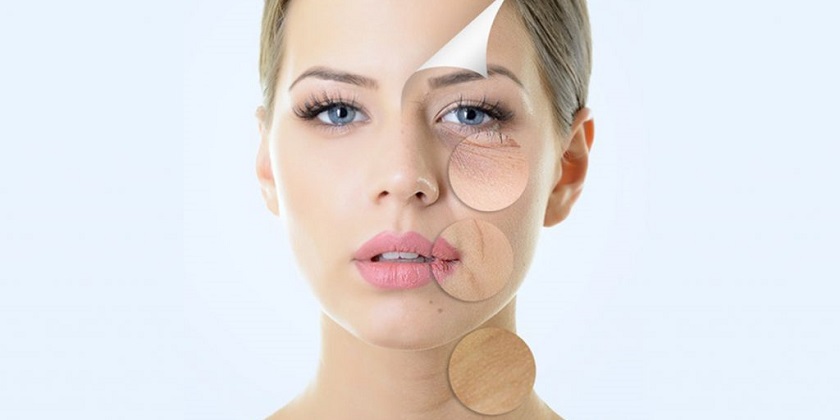- Home
- Wrinkles Reduction

What causes wrinkles?
There are many factors that contribute to the onset of wrinkles. The following are the most important:
Aging
Wrinkles are a natural by-product of the aging process. With age, skin cells divide more slowly. The inner layer of the skin, called the dermis, begins to thin. The network of elastin and collagen fibers, which support the outer layer, loosens and unravels. This process results in depressions on the skin surface. With aging, skin becomes more fragile. Also, oil-secreting glands are less efficient, making the skin less able to retain moisture and appear more wrinkled. All of these factors contribute to the development of wrinkles.
Facial muscle contractions
Lines between the eyebrows (“eleven” or frown lines) and lines coming out from the corner of the eyes (crow's feet) are believed to develop because of the underlying muscle contractions. Smiling, frowning, squinting, and other habitual facial expressions cause these wrinkles to become more prominent with age. Over time the expressions, along with gravity and the loss of underlying bone and fat mass, contribute to the formation of jowls and drooping eyelids.
Sun damage
Excessive exposure to ultraviolet radiation (too much sun) can result in premature aging of the skin, also known as photoaging. The ultraviolet sun rays that cause photoaging damage collagen fibers (the major structural proteins in the skin) and elastin fibers (the protein that enables skin to stretch). Both of these fibers are important components of the skin’s connective tissue. Without them, the skin loses its strength and flexibility, leading to wrinkles. When ultraviolet light damages skin tissue, certain enzymes are produced. These enzymes create and reform collagen. During the process, however, some healthy collagen fibers are damaged, resulting in a disorganized formation of fibers called solar scars. Wrinkles develop when this rebuilding process occurs over and over.
Smoking
Healthy skin always regenerates. While old collagen is broken down and removed, new collagen is being produced and installed. Researchers have found that smoking tobacco products cause a reduction in the production of new collagen. A lack of new collagen results in the development of wrinkles. This may also be due to the lack of blood supply to the skin caused by smoking.
What are the treatment options for wrinkles?
Removing skin layers to reduce wrinkles or irregular depressions is an effective way to regain smoother, more youthful looking skin. Dermabrasion (scraping layers away) and chemical peels(dissolving skin away) are two of the traditional methods used in skin resurfacing. Additional techniques have been developed to repair prematurely aging skin. These include the following:
Laser skin resurfacing
Laser skin resurfacing is a treatment to reduce facial wrinkles and irregularities caused by sun damage or acne. The laser technique directs short, concentrated pulsating beams of light at irregular skin. Ablative laser skin resurfacing removes skin very precisely, layer by layer, which stimulates the growth of new collagen fibers. This mode of the laser also results in fewer problems with hypopigmentation (lightening of the skin). Non-ablative laser resurfacing promotes the development of new more healthy collagen, helping to restore the skin contour and appearance with minimal downtime. Fractional laser technology is also available. The laser light is delivered in a grid allowing normal, untreated skin to remain within the treated area, which leads to quicker healing.
You are an ideal candidate for laser skin resurfacing if you have:
- Fine lines under or around the eyes, forehead, or mouth
- Wrinkles under or around the eyes, forehead, or mouth
- Scars from acne
- Non-responsive skin after a facelift
If you have active acne, you should wait until your acne is well controlled before pursuing laser treatment. Patients who were recently treated with Accutane® should wait for at least six months after their last dose before laser resurfacing. Laser resurfacing is generally better suited for fair-skinned individuals, as dark-skinned individuals have a higher risk of hyperpigmentation (darkening of the skin) with certain treatments. Exposure to the sun after this treatment should be avoided for 3 months.
Botulinum toxin type A (Botox®) injection therapy
Botox® is a medicine derived from the botulinum toxin. It blocks the chemical signals that cause muscles to contract. Botox is injected into the muscles whose contractions cause wrinkles, such as between the eyebrows (frown lines) and the lines that radiate from the corner of the eyes (crow's feet). The effects of Botox usually last for 3 to 4 months. When the Botox wears off, the muscles again become active and the wrinkles will begin to reform. The treatment would then be repeated. If you choose not to repeat the injections, your wrinkles will return to no worse than they were initially.
There might be temporary redness, bruising, or stinging around the Botox injection site(s). In extremely rare cases, there might be a slight lid droop for several days after the injection, but all reported side effects have been temporary.
Fillers
Wrinkles that remain at rest may require filler to fill-in or lift up skin that is depressed. Prominent folds around the mouth, nose, and chin are the most commonly treated. Hyaluronic acid, a natural occurring sugar polymer, is the most common filler used. Most fillers are temporary, providing improvement for around 4 to 6 months, at which time the treatment would need to be repeated. Side effects may include bruising, temporary swelling, and pain.
Facelift
A facelift is a surgical procedure during which excess skin and fat is removed from the face and neck. Tightening of the muscular and connective tissue layers is also performed. The results usually last 7 to 10 years.
Sun damage: Prevention and treatment
Sun exposure should be minimized to prevent further wrinkles and sun damage. Daily use of sun screen is very important in prevention. There are treatments to repair prematurely aging skin including topical retinoids and glycolic acid. If there is significant damage, photodynamic (blue light) treatment and/or topical chemotherapy creams such as 5-fluorouracil are also sometimes used.

